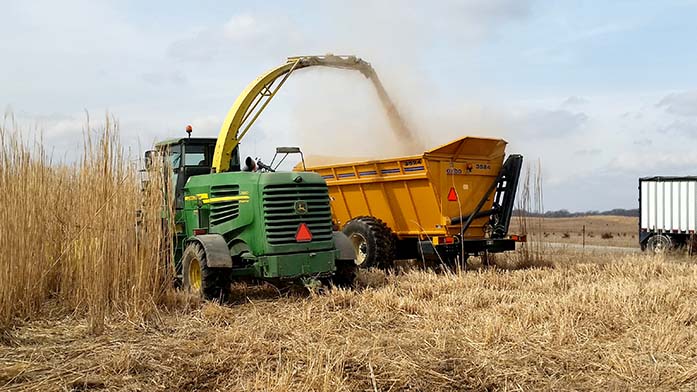The UI is turning toward more sustainable energy by growing fuel locally.
By Katelyn Weisbrod
[email protected]
In a state known for its agriculture, the University of Iowa is growing and harvesting its own renewable-energy source.
This week, two UI-owned fields of giant miscanthus are being harvested to supply the UI with another year of partially renewable fuel. Miscanthus is a 12-foot tall bamboo-like grass blended with coal to help power the UI as part of the University’s Biomass Fuel Project.
The miscanthus project is one of the UI’s methods to achieve its 2020 sustainability goals, which include consuming 40 percent renewable energy. Currently, the grass supplies approximately 5 percent of the energy produced in the Power Plant, but this is just the beginning.
“The Biomass Fuel Project is one of the ways we are reducing the use of fossil fuels by substituting locally available renewable materials in the main Power Plant,” said George McCrory, UI Sustainability communications specialist. “Giant miscanthus is being harvested and used to help supply power, steam, and chilled water to the main campus.”
UI Facilities Management environmental compliance specialist Ingrid Anderson said this year’s harvest is relatively small compared with what the office will do in years to come. The future goal is to have approximately 2,500 acres of miscanthus to harvest. The UI currently only grows around 300 acres, most of which is too immature to harvest, she said.
“After the first year, you only get about a third of the product you’d get from a fully matured plant,” Anderson said. “We decided to not harvest those fields to give them an opportunity to stand in the field longer.”
The project began in 2013 and began on a commercial level in 2015, so each field is no more than a few years old. Each year, the field produces a larger crop.
Anderson said growing miscanthus costs about the same as burning just fuel.
“There are a number of reasons for us to do it; this is essentially an opportunity to locally produce fuel purchased from local farmers and to displace some fossil fuels with renewable fuel,” Anderson said.
The two fields that are being harvested are in Muscatine County and near Iowa City. Local farmer Dan Black tends the Iowa City miscanthus field, which was planted two years ago.
“This is a perennial crop; it only plants once, and it will come back every year,” Black said. “That’s part of the sustainability of the whole project, only one planting expense.”
Miscanthus also contributes to sustainability of the operation through a process called senescence, which is the reason the plant’s harvested so late.
“The nutrients dry out of the plant and go back into the roots in a process called senescence,” Black said. “Then the nutrients are available for the next year’s crop, and that’s a intricate part of the plant.”



